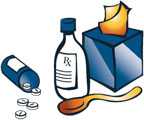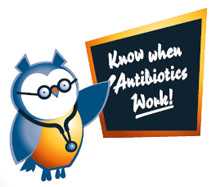Brochure for Parents: Snort. Sniffle. Sneeze. No Antibiotics Please.
Print-friendly color version [1 page]
Print-friendly black & white version [1 page]
Español: Campaña para promover el uso correcto de los antibióticos
When your child is sick, you want to do everything you can to help. But antibiotics are not the answer for every illness. This brochure will help you know when antibiotics work – and when they won’t. For more information, talk to your healthcare provider or visit www.cdc.gov/getsmart.
The Risk: Bacteria Become Resistant

What’s the harm in giving your child antibiotics anytime? Taking antibiotics when they are not needed can cause some bacteria to become resistant to the antibiotic.
These resistant bacteria are stronger and harder to kill. They can stay in your child’s body and can cause severe illnesses that can’t be cured with antibiotics. A cure for resistant bacteria may require stronger treatment – and possibly a stay in the hospital.
To help prevent antibiotic resistance, the Centers for Disease Control and Prevention (CDC) recommends giving your child antibiotics only when necessary.
Antibiotics Aren’t Always the Answer

Most illnesses are caused by two kinds of germs: bacteria or viruses. Antibiotics can cure bacterial infections – not viral infections.
Bacteria cause strep throat, some pneumonia and sinus infections. Antibiotics can work.
Viruses cause the common cold, most coughs and the flu. Antibiotics don’t work.
Using antibiotics for a virus:
- Will NOT cure the infection
- Will NOT help you feel better
- Will NOT keep others from catching your illness
Protect Your Child, Give the Best Care

Antibiotics should not be used to treat the common cold, runny noses and most coughs. Children fight off these viral illnesses on their own.
If your child’s healthcare provider prescribes an antibiotic to treat a bacterial infection – like strep throat – be sure to give your child all of the medicine. Only using part of the prescription means that only part of the infection has been treated. Not finishing the medicine can cause resistant bacteria to develop.
Talk to Your Healthcare Provider to Learn More
GET SMART…

- Antibiotics are strong medicines, but they don’t cure everything.
- When not used correctly, antibiotics can actually be harmful to your child’s health.
- Antibiotics can cure most bacterial infections. Antibiotics cannot cure viral illnesses.
- Antibiotics kill bacteria – not viruses.
- When your child is sick, antibiotics are not always the answer.
Commonly Asked Questions:
Q: How Do I Know if My Child has a Viral or Bacterial Infection?
A: Ask your child's healthcare provider and follow his or her advice on what to do about your child's illness.
Remember, colds are caused by viruses and should not be treated with antibiotics.
Q: Does This Mean I Should Never Give My Child Antibiotics?
A: Antibiotics are very strong medicines and should be used to treat bacterial infections. Your healthcare provider will prescribe antibiotics if your child has a bacterial infection.
Q: If Mucus from the Nose Changes from Clear to Yellow or Green — Does This Mean That my Child Needs an Antibiotic?
A: No. Yellow or green mucus does not mean that your child has a bacterial infection. It is normal for mucus to get thick and change color during a viral cold.
USE ANTIBIOTICS WISELY.
Talk with your healthcare provider about the right medicines for your child’s health.
For more information, see the Centers for Disease Control and Prevention website at: www.cdc.gov/getsmart/community or call 1-800-CDC-INFO
U.S. Department of Health and Human Services
Centers for Disease Control and Prevention
- Page last reviewed: April 17, 2015
- Page last updated: April 17, 2015
- Content source:


 ShareCompartir
ShareCompartir